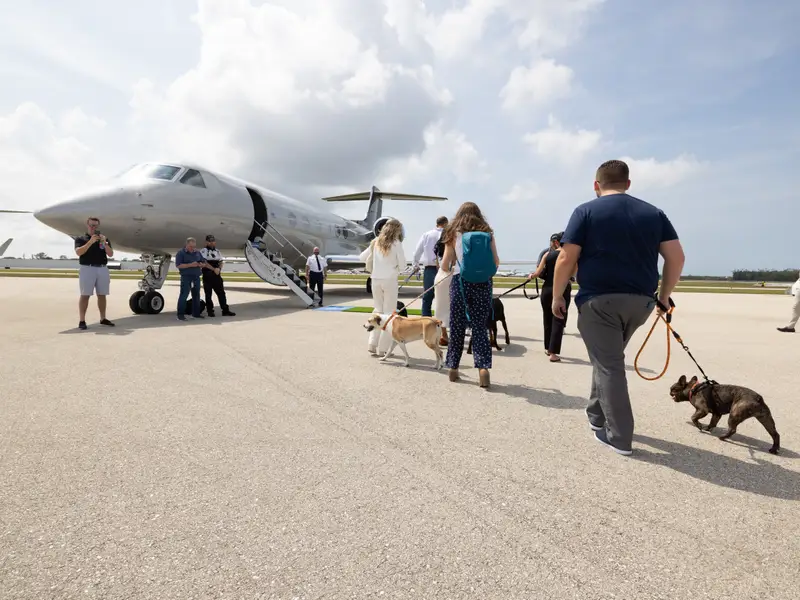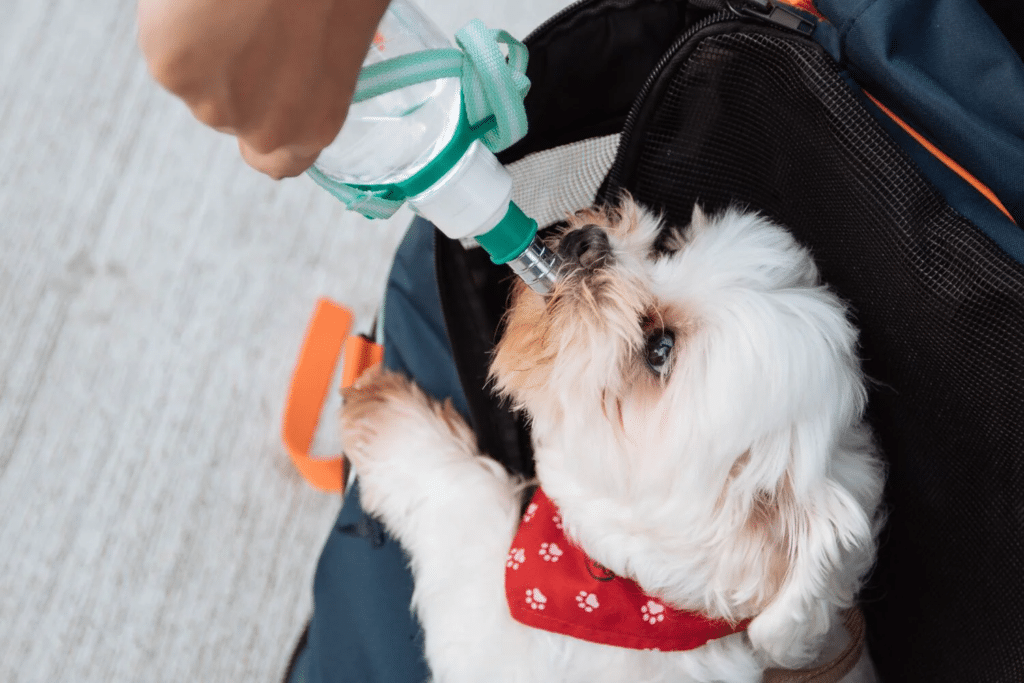
What Are The Best Tips For Air Travel With Dogs To Ensure A Safe Journey?
Traveling with a dog can be a rewarding experience, but when it comes to air travel, preparation is key to ensuring a safe and stress-free journey for both you and your furry friend. Whether you’re flying domestically or internationally, traveling with a dog requires careful planning and attention to detail to avoid unnecessary stress for your pet and ensure their safety and comfort.
In this article, we will explore the best tips for air travel with dogs, covering everything from choosing the right airline to preparing your dog for the flight. We’ll also address frequently asked questions to help you navigate air travel with your dog more efficiently.
Table of Contents
ToggleKey Takeaways
- Preparation is Essential: Ensure your dog is in good health and accustomed to their travel crate well in advance of your flight.
- Choose the Right Airline: Research pet policies, book early, and ensure the airline offers a comfortable environment for your dog.
- Keep Your Dog Calm: Use familiar items, calming music, and pheromone products to help reduce your dog’s anxiety during the flight.
- Plan for Post-Flight Care: Allow time for your dog to adjust after the flight, offer water, and monitor them for signs of discomfort.
- Check All Regulations: Understand the rules around traveling with pets, including documentation, size restrictions, and safety regulations.
Preparing Your Dog for Air Travel

Before you even think about booking your flight, it’s crucial to prepare your dog for air travel. This involves getting them used to their crate, health checks, and understanding any rules that may apply to their breed or size.
1. Visit the Vet
- Health Check: A visit to the vet is essential before any travel, especially if it’s a long flight. Ensure your dog is up-to-date on vaccinations and that they’re in good health to handle the stress of flying. Some airlines require a health certificate issued within a certain timeframe before travel (usually 10 days).
- Sedation: Avoid sedating your dog unless absolutely necessary. Sedatives can interfere with their ability to regulate body temperature, which can be dangerous during flight.
- Microchip & ID Tags: If your dog isn’t already microchipped, consider getting this done before travel. It’s an extra layer of security in case they get lost. Also, ensure they have updated ID tags with your contact information.
2. Get Your Dog Used to Their Travel Crate
- Choose the Right Crate: Your dog’s travel crate should be well-ventilated, large enough for them to stand up, turn around, and lie down comfortably. Ensure that the crate is airline-approved and meets the International Air Transport Association (IATA) guidelines.
- Crate Training: Begin crate training your dog at least a few weeks before your flight. Familiarize them with the crate by using treats and toys to encourage positive associations. Take them on short trips in the crate so they get used to being confined.
- Comfort Items: Place your dog’s favorite blanket or toy inside the crate. The familiar scent will help reduce anxiety during the flight.
3. Practice in a Safe Environment
- Introduce Your Dog to New Environments: Take your dog on car rides to simulate the travel experience. The more your dog is exposed to different transportation modes, the less stressful they’ll find the journey.
Choosing the Right Airline for Your Dog
Not all airlines are equally equipped for air travel with pets. Some are more pet-friendly and have better accommodations for your dog, while others have restrictive policies or uncomfortable conditions. Researching and choosing the right airline for your dog can significantly impact the overall travel experience.
1. Understand Airline Policies
- Cabin or Cargo Hold: Small dogs are typically allowed in the cabin if they fit in a carrier under the seat, while larger dogs may need to travel in the cargo hold. Check each airline’s pet policy to determine what size or weight restrictions they have.
- Pet Fees: Most airlines charge pet fees for in-cabin travel, and they can vary. Make sure to check the cost and ensure that it fits within your budget.
- Airline Reputation: Look for reviews and testimonials from other dog owners about the airline’s pet services. Some airlines have dedicated pet care teams that ensure your dog’s comfort during travel, while others may not be as attentive.
2. Book Early and Confirm Pet Availability
- Pet Reservations: Airlines typically only allow a limited number of pets on each flight, so it’s important to book your dog’s spot well in advance. Make sure to call the airline and confirm your pet’s reservation to avoid last-minute surprises.
- Direct Flights: Whenever possible, book a direct flight to minimize your dog’s time in transit. Long layovers or changes of planes can increase the chances of your dog becoming stressed or uncomfortable.
3. Check for Pet Amenities
- In-Cabin Comfort: Look for airlines that offer in-cabin amenities for pets, such as water bowls, blankets, or temperature-controlled cabins.
- Pet Services: Some airlines offer special services like pet lounges at airports, pet relief areas, and priority boarding for pet owners.
On the Day of Travel: Tips for a Smooth Experience
Once the day of travel arrives, there are several steps you can take to ensure your dog’s safety and comfort throughout the journey. Preparation is key, as the day can be filled with stress and commotion, so minimizing last-minute surprises will help everyone stay calm.
1. Arrive Early
- Arriving early at the airport will give you plenty of time to check in, get through security, and address any unexpected issues. Airlines that allow pets often require extra time for check-in, especially for those traveling in the cargo hold.
2. Exercise Before the Flight
- Take a Walk: Before heading to the airport, take your dog for a long walk or play session. This will help burn off excess energy and reduce stress.
- Bathroom Breaks: Make sure to give your dog a bathroom break before entering the airport. Many airports now feature pet relief areas where you can take your dog to relieve themselves before the flight.
3. Prepare for Security Screening
- Prepare for Pet Screening: At security, you’ll likely be asked to remove your dog from their carrier and carry them through the metal detector while the carrier is scanned separately. Ensure your dog is securely leashed and under control.
- Avoid Stressful Situations: If your dog is particularly anxious, it might help to have a calming solution like a pheromone spray or a calming collar. Many dogs feel the stress of the airport environment, so try to stay calm and reassuring.
During the Flight: Ensuring Comfort
Now that you and your dog are on the plane, the next focus is to make sure they remain as comfortable as possible during the flight.
1. In the Cabin: Monitor Your Dog
- Keep the Carrier Under the Seat: If your dog is traveling in the cabin, ensure their carrier is placed under the seat in front of you at all times. Avoid removing your dog from the carrier during the flight unless it’s absolutely necessary.
- Calming Music or Apps: Some dogs are comforted by soft, soothing music. Consider using calming pet apps or music playlists to help your dog relax during the flight.
2. In the Cargo Hold: Special Considerations
- Choose the Right Flight Times: If your dog must travel in the cargo hold, opt for flights during mild weather conditions. Avoid extreme temperatures or long delays that could expose your dog to uncomfortable conditions.
- Monitor Temperature and Ventilation: Ensure the cargo hold is well-ventilated and climate-controlled. Most airlines with pet cargo services have dedicated staff to ensure your dog’s safety, but checking the airline’s specifics is still a good idea.
Post-Flight: Once You Arrive
Upon arrival, it’s important to check on your dog’s well-being. This ensures that they are feeling good after the flight and have everything they need.
1. Rehydrate and Give Your Dog Time to Adjust

- Provide Water: Dogs can become dehydrated during long flights, especially if they’ve been in the cargo hold. Make sure to offer your dog water as soon as possible after the flight.
- Let Them Stretch: Take your dog for a walk once you reach your destination to allow them to stretch their legs and recover from being confined to a carrier for hours.
2. Look for Signs of Stress or Injury
- Physical Check: Check your dog for any signs of stress, injury, or discomfort after the flight. If they’re displaying unusual behavior, such as excessive panting or limping, consult a vet.
Ensuring Comfort for Your Dog During the Flight
1. Stay Calm and Reassuring
- Dogs are very sensitive to their owners’ emotions, and if you appear anxious or stressed, your dog may pick up on those emotions. Stay calm and act reassuring, especially during check-in, security checks, and takeoff. A calm and confident demeanor from you can help your dog feel more relaxed.
2. Comfortable Carrier Placement
- For in-cabin flights, it’s important that the carrier is placed properly under the seat. Make sure that the door is facing toward the seat, and avoid overpacking the carrier with items. You want to ensure your dog has enough space to stand, turn around, and lie down comfortably.
- Important Tip: If you’re traveling with a dog that’s larger or has specific health conditions, ensure that the carrier is ventilated properly and meets the IATA standards.
3. Avoid Feeding Before the Flight
- A full stomach during travel can make your dog feel uncomfortable, especially if they experience motion sickness. It’s advisable to feed your dog a light meal a few hours before the flight, and avoid heavy meals right before departure. This will also reduce the risk of vomiting or nausea during the flight.
Addressing Common Concerns When Traveling with Dogs
1. Managing Flight Duration
- Long flights can be difficult for dogs, especially if they’re not accustomed to long periods of confinement. If your dog is flying in the cabin, choose a flight that is as direct as possible to minimize the time spent in the air.
- If your dog is traveling in the cargo hold, make sure that they’re comfortable and that the airline offers a climate-controlled environment for pets. Cargo holds are usually pressurized and temperature-controlled, but you should still confirm this with the airline beforehand.
2. Managing International Travel for Pets

- Traveling internationally with a dog requires more than just booking a flight. Many countries have strict regulations regarding the import of pets, which may include quarantine periods, specific vaccinations, and microchip requirements. Research the pet import laws for your destination country well in advance.
- Important Tip: Start planning international travel for your dog several months ahead of your departure. Some vaccinations and health tests may need to be scheduled months in advance, and documentation can take time to process.
Can I Travel with a Puppy or an Older Dog?
Traveling with a puppy or an older dog requires extra considerations. Puppies may not have the stamina to handle long flights, and older dogs may have health concerns that could complicate air travel.
1. Puppies: Special Considerations
- Health Requirements: Most airlines require dogs to be at least 8 weeks old before flying. However, puppies may not be fully vaccinated at this point, so check your airline’s policy regarding puppy age restrictions and vaccinations.
- Monitor Their Comfort: Puppies are more susceptible to motion sickness, so take extra steps to ensure they’re comfortable. Consider limiting the amount of food they consume before the flight to prevent nausea.
2. Senior Dogs: Extra Care
- Health Checks: Older dogs may suffer from arthritis, breathing issues, or other age-related concerns. Consult with your vet to ensure that your dog is healthy enough for travel and discuss any special accommodations they may need.
- Medication: If your older dog takes medication, ensure you have enough for the duration of the trip, and pack any necessary prescriptions in your carry-on luggage. Always check the rules regarding flying with medications before your flight.
- Comfort: Senior dogs often experience joint stiffness, so ensure they have a soft, padded area to rest during the flight. A comfortable bed or blanket in their crate can provide extra cushioning and support.
After the Flight: How to Help Your Dog Adjust
Once you land, your dog may still need some time to recover from the flight. Here are a few additional steps to help them settle in after traveling:
1. Take Your Dog for a Walk as Soon as Possible
- After a long flight, your dog will likely be restless. Take them for a walk immediately after disembarking from the plane, if possible. This helps them stretch their legs, release built-up energy, and go to the bathroom.
2. Monitor Behavior for Stress or Illness
- After the flight, keep an eye on your dog for any unusual behavior, such as excessive panting, drooling, or lethargy. While these behaviors could simply be a reaction to the travel experience, they could also indicate stress or health concerns. If any symptoms persist, it’s best to consult a veterinarian.
3. Settle Into the New Environment
- If you’ve traveled to a new destination, help your dog settle into their new surroundings. Make sure they have access to their food, water, and familiar items like their bed or toys. This will provide them with a sense of comfort and security in their new environment.
Additional Considerations for Air Travel with Dogs
While we’ve covered a comprehensive guide for preparing and traveling with your dog on an airplane, there are still several additional points worth mentioning to make the experience even smoother for both you and your pet.
Traveling with Dogs and Their Food
Feeding your dog before the flight is essential, but so is ensuring you have the right food and treats for them during the journey.
Dog Food During the Flight
- Pack Enough Food: If your dog requires a special diet, make sure to pack enough food for the entire duration of the flight, including any layovers. It’s best to store food in a sturdy, airtight container to keep it fresh.
- Treats for Comfort: Small treats can be given to your dog during the flight to help calm them and keep them occupied. Avoid feeding them a large meal immediately before flying to prevent motion sickness.
- Hydration: Ensure your dog has access to water throughout the journey. Many pet travel crates are designed with water bowls that can be attached inside. For in-cabin travel, you may need to provide your dog with water at regular intervals.
Dealing with Layovers
Layovers can be stressful for both you and your dog, so managing them effectively is essential. If your pet is traveling in the cargo hold, the key concern is how long they will be confined to the crate and whether they have a chance to stretch their legs.
Managing Layovers
- Pet Relief Areas: Look for airports that have designated pet relief areas. Some airports have great facilities with enclosed spaces where you can let your dog out of their crate for a bathroom break and a short walk.
- Time Management: If you have a long layover, plan ahead by researching pet-friendly lounges or finding a quiet area to wait. Be sure to give your dog a chance to stretch and relieve themselves if the airport has a pet relief area.
- Plan for Delays: Flight delays are inevitable, but ensure your dog is comfortable throughout the delay. Keep snacks, water, and comfort items readily accessible in case the layover extends longer than expected.
Traveling with Multiple Dogs
Traveling with more than one dog can be tricky, especially if you’re flying internationally or using a different airline. The key is ensuring each dog has enough space, comfort, and safety measures.
Traveling with Multiple Dogs
- Separate Crates: Even if your dogs get along well, it’s safer to put them in separate crates during the flight. Crates should be spacious enough for your dog to stand, sit, turn around, and lie down comfortably.
- Coordinating with the Airline: Some airlines limit the number of pets allowed on each flight, so it’s essential to confirm ahead of time that they can accommodate all your dogs. Larger dogs may need to fly in the cargo hold, which requires specific arrangements.
- Managing Dogs During Layovers: If you’re flying with multiple dogs, managing them during layovers can become even more complicated. Ensure you have enough time between connecting flights to handle all of your pets’ needs—bathroom breaks, feeding, and hydration.
International Travel: Extra Precautions and Documentation
Traveling with your dog internationally requires more than just a flight reservation. You’ll need to navigate pet import regulations specific to your destination, which can vary dramatically depending on the country.
Research Pet Import Laws
- Import Permits: Certain countries require pets to have specific import permits, quarantine periods, or even microchips for entry. Start the process early—ideally months in advance—so you have plenty of time to meet these regulations.
- Vaccinations and Documentation: Most countries require proof of vaccinations (such as rabies), as well as health certificates stating that your dog is fit to travel. Ensure your vet provides the correct documentation in the proper format required by the destination country.
- Quarantine Periods: In some countries, particularly in places like Australia, your dog may have to undergo a quarantine period upon arrival. This can range from a few days to several weeks, depending on the regulations of that country.
Stress-Free Travel for Dogs with Special Needs
If you’re traveling with a dog that has special needs, whether it’s a medical condition, anxiety, or behavior challenges, it’s important to take additional steps to make the journey comfortable and stress-free.
Traveling with Anxious Dogs

- Calming Solutions: Anxiety wraps or calming pheromone sprays can help alleviate stress during the flight. Products like Adaptil or Thundershirt have been proven to reduce anxiety in many dogs.
- Consult a Veterinarian: If your dog has anxiety or behavior issues, it’s important to speak with your veterinarian. They may recommend anti-anxiety medications or behavior techniques to prepare your dog for the flight.
- Provide Extra Comfort: Use soft bedding or familiar items like your dog’s favorite blanket, as these can provide comfort during the flight. Familiar smells and sounds can help reduce anxiety.
Traveling with Senior or Ill Dogs
- Medical Preparations: Older dogs or those with medical conditions may need special arrangements. Speak with your vet about the best ways to keep your senior dog comfortable, and whether any extra medications or adjustments are necessary for the flight.
- Frequent Breaks: If your dog has mobility issues, plan frequent breaks before and after the flight. Make sure they have enough space to move comfortably in their crate.
Also Read: What Are The Best Tips For A Stress Free Air Travel Experience?
Conclusion
Air travel with dogs can be a smooth and successful experience when you take the time to properly prepare, choose the right airline, and make sure your pet is comfortable throughout the journey. By considering factors such as health checks, crate training, airline policies, and post-flight care, you can ensure that your dog has a safe and pleasant flight experience.
Remember, the key to stress-free air travel with dogs is preparation. If you plan ahead, follow the tips and guidelines, and remain calm throughout the process, both you and your dog will be able to enjoy the journey without unnecessary stress or complications.
FAQs
Can I bring my dog on the plane with me?
Small dogs that fit in a carrier under the seat in front of you are typically allowed in the cabin. Larger dogs may need to travel in the cargo hold.
Do I need a health certificate for my dog to fly?
Yes, most airlines require a health certificate from your vet stating that your dog is fit to travel. This is especially necessary for international travel.
Can I sedate my dog for the flight?
It’s not recommended to sedate your dog for air travel, as sedation can cause health risks, especially in pressurized cabins. Consult with your vet for alternatives if your dog experiences anxiety.
How can I help my dog cope with flight anxiety?
Use calming aids such as pheromone sprays or anxiety wraps. Familiar items like blankets and toys in the crate can also provide comfort.
Can I feed my dog before the flight?
It’s a good idea to feed your dog a light meal a few hours before the flight to avoid travel sickness. Avoid feeding them too close to departure time.
What should I do if my dog gets lost during the flight?
Ensure your dog has proper identification and consider microchipping them before travel. If they go missing, immediately contact the airline’s customer service.
How do I find pet-friendly airlines?
Research airlines with established pet policies. Many airlines allow pets in the cabin, but always check reviews and ratings to ensure a positive experience for your dog.


